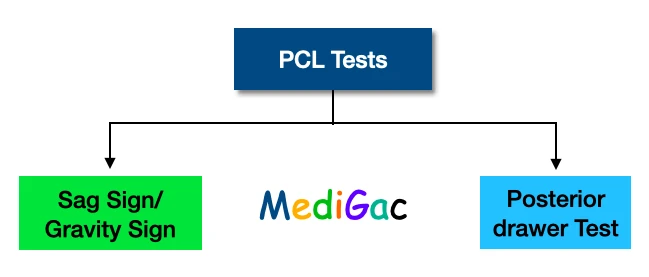PCL tests includes – Posterior drawer test, Gravity sign/sag sign tests. Positive and Negative tests findings.
Here we have discussed mainly two tests :

- Sag sign/Gravity sign
- Posterior drawer test
I. Sag sign/Gravity sign :
1. Purpose :
To determine the function of the posterior cruciate ligament’s integrity (PCL).
2. Procedure :
- The patient is said to lie-down in supine position with the hips flexed to 45 degree and knee flexed to 90 degree.
- Now if the PCL is torned, then the tibia drops or sags by posteriorly on the femur due to gravity.
- Generally the tibial plateau extends 1cm anteriorly, beyond the femur or condyle.
3. Clinical findings :
Positive findings :
- The test is said to be positive if the patient gets able to extend his knee while the examiner fixed the patients hip at 90-100 degree.
- This action is sometimes called the voluntary anterior drawer, because the result are comparable with anterior drawer chest.
II. Posterior drawer test :
1. Purpose –
To determine the function of the posterior cruciate ligament’s integrity (PCL).
2. Procedure –
- The patient is said to lie-down in supine position, with the hip flexed at 45 degree and the knee flexed at 90 degree.
- Then we can fixate this position by slighltly sitting on the foot of the patient.
- Then we have to palpate the joint line and pushing the tibia posteriorly in an explosive movement.
3. Clinical findings –
Positive findings :
- This test is said to be positive if the tibia translate posteriorly more than 6mm or sometimes the examiner can experience a softly wishing and feeling.